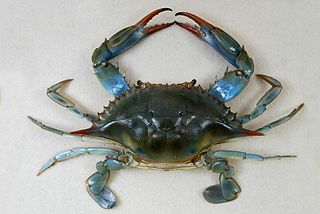
Callinectes sapidus, the blue crab, Atlantic blue crab, or, regionally, the Maryland blue crab, is a species of crab native to the waters of the western Atlantic Ocean and the Gulf of Mexico, and introduced internationally.
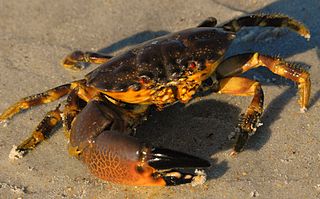
The Florida stone crab is a crab found in the western North Atlantic, from Connecticut to Colombia, including Texas, the Gulf of Mexico, Belize, Mexico, Jamaica, Cuba, The Bahamas, and the East Coast of the United States. The crab can also be found in and around the salt marshes of South Carolina and Georgia. It is widely caught for food. The closely related species Menippe adina is sometimes considered a subspecies – they can interbreed, forming hybrids – and they are treated as one species for commercial fishing, with their ranges partly overlapping. The two species are believed to have diverged approximately 3 million years ago.

Portunus pelagicus, also known as the blue crab, blue swimmer crab, blue manna crab and flower crab is a species of large crab found in the Indo-Pacific, including off the coasts Indonesia, Malaysia, Cambodia, Thailand, the Philippines, and Vietnam; and in the intertidal estuaries around most of Australia and east to New Caledonia.

Portunus trituberculatus, also known as the gazami crab, Asian blue crab or horse crab, is the most widely fished species of crab in the world. It is found off the coasts of East Asia and is closely related to Portunus armatus.

Charybdis is a genus of swimming crabs in the family Portunidae. It is named after the monster Charybdis of Greek mythology.

The Peel-Harvey Estuarine System is a natural estuarine system that lies roughly parallel to the coast of Western Australia and south of the town of Mandurah.

Ovalipes catharus, commonly known as the paddle crab, swimming crab, or, in Māori, pāpaka, is a species of crab in the family Ovalipidae. It is found in shallow, sandy-bottomed waters around the coasts of New Zealand, the Chatham Islands, and uncommonly in southern Australia. O. catharus is an opportunistic, aggressive, and versatile feeder active mostly at night, preying predominantly on molluscs and crustaceans. It is also highly prone to cannibalism, which accounts for over a quarter of its diet in some locations. The crab's paddle-shaped rear legs and streamlined carapace allow it to capture prey by swimming rapidly and to escape predation by burrowing in the sand. Its mating season is in winter and spring; the male carries the female until she moults, after which the two mate and the female likely moves into deeper waters to incubate and disperse her larvae.
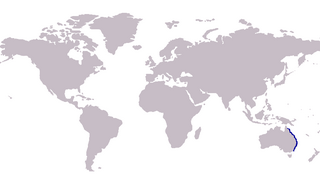
The trumpeter whiting, also known as the winter whiting or diver whiting, is a common species of coastal marine fish of the smelt-whiting family, Sillaginidae. The trumpeter whiting is endemic to Australia, inhabiting the eastern seaboard from southern New South Wales to northern Queensland. The species is found in bays, estuaries, coastal lakes and mangrove creeks on silty and muddy substrates in waters ranging from 0 to 30 m deep, occasionally inhabiting sandy and seagrass beds.

Ovalipes australiensis, commonly known as the sand crab or the surf crab, is a species of crab in the family Ovalipidae. Its range extends from Western Australia to Queensland, including Tasmania. It is fished commercially.

Crab fisheries are fisheries which capture or farm crabs. True crabs make up 20% of all crustaceans caught and farmed worldwide, with about 1.4 million tonnes being consumed annually. The horse crab, Portunus trituberculatus, accounts for one quarter of that total. Other important species include flower crabs, snow crabs (Chionoecetes), blue crabs, edible or brown crabs, Dungeness crab, and mud crabs, each of which provides more than 20,000 tonnes annually.

Callinectes similis, sometimes called the lesser blue crab or dwarf crab, is a West Atlantic species of blue crab. It was described by Austin B. Williams in 1966.

Coastal fish, also called inshore fish or neritic fish, inhabit the sea between the shoreline and the edge of the continental shelf. Since the continental shelf is usually less than 200 metres (660 ft) deep, it follows that pelagic coastal fish are generally epipelagic fish, inhabiting the sunlit epipelagic zone. Coastal fish can be contrasted with oceanic fish or offshore fish, which inhabit the deep seas beyond the continental shelves.

Alpheus heterochaelis, the bigclaw snapping shrimp, is a snapper or pistol shrimp in the family Alpheidae. It is found in the western Atlantic Ocean and the Gulf of Mexico.

Portunus sayi, the sargassum swimming crab, is a species of pelagic crab in the family Portunidae. It is found in the western Atlantic Ocean and the Caribbean Sea where it makes its home among floating mats of Sargassum seaweed. It was named in honour of the American naturalist Thomas Say.
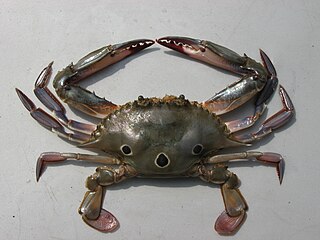
Portunus sanguinolentus, the three-spot swimming crab, blood-spotted swimming crab or red-spotted swimming crab, is a large crab found throughout estuaries of the Indian and West Pacific Oceanic countries.
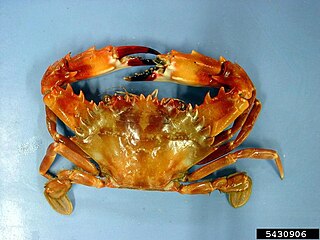
Charybdis hellerii, the Indo-Pacific swimming crab or spiny hands is a species of crab from the swimming crab family, the Portunidae. Its native range covers the Indian and Pacific Oceans but it has been introduced to the western Atlantic and has invaded the Mediterranean. It is a commercially exploited species in south-east Asia.
Charybdis longicollis, the lesser swimming crab, is a species of crab from the swimming crab family, the Portunidae. It has a native range which covers the north-western Indian Ocean and it has invaded the Mediterranean Sea by Lessepsian migration through the Suez Canal.

Portunus segnis, the African blue swimming crab, is a species of crustacean, a swimming crab belonging to the family Portunidae. While native to the western Indian Ocean, it is also invasive in the Mediterranean. It is thought to have come through the Suez Canal from the Red Sea but it may have been transported by ships.

Macrophthalmus crassipes is a species of sentinel crab in the family Macrophthalmidae, found around China, Thailand, Malaysia, Australia, and the Caroline Islands. In Australia it is found from north Western Australia through to New South Wales. Common names include the seagrass sentinel crab and the orange spined sentinel crab. On adult males there is a substantial tooth on the lower claw and a much smaller tooth on the upper claw, and noticeable orange spines on the “wrist” (carpus) of the clawed leg and on the palm of the clawed leg. The carapace is covered in small granules, and is up to around 37 mm (1.5 in) across. It is a burrowing crab, and lives in open tidal flats, muddy or with sandy mud, low on tidal creek banks, and adjacent mangroves.


















